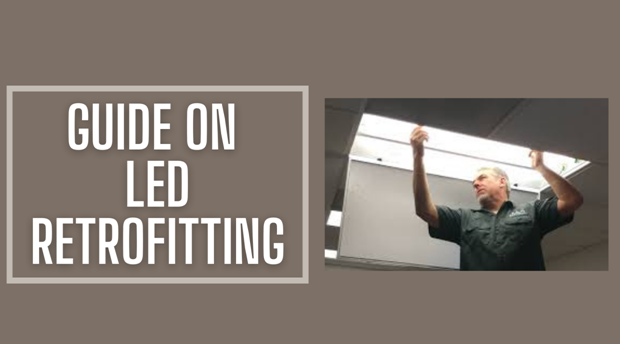LED retrofitting is one of the popular activities in the world of lighting technology today. Many have retrofitted or are considering LED retrofitting because LEDs are highly energy-efficient and offer other benefits.
If you are also thinking about retrofitting your lighting facility to LED but are not certain how to go about it, then this guide will be very helpful for you. Here, we will discuss everything you need to know about LED retrofitting.
So, let’s get started.

Simply put, LED retrofitting is an act or process of adding LED components to the existing lighting system in order to convert the system into an LED lighting system. LED retrofitting is the most common retrofit happening today because of the increasing popularity of LED technology.
LED retrofitting can be done in different ways. Let’s briefly discuss the types of LED retrofitting.
In this method, emergency LED tubes are equipped with an internal emergency driver so that they can function with existing ballasts of fluorescent. Prior to retrofitting this way, potential compatibility issues between new LED tubes and existing ballasts must be reviewed and evaluated so that the retrofitting will provide good performance. There might be cases when LED tubes are not compatible with ballasts although they are from the same manufacturer.
The advantages of this type of LED retrofitting are easy and quick installation and low installation cost. However, the ballast compatibility issues could impact the performance of the system.
Another type of retrofitting is to operate LED tubes on line voltage power instead of operating on the voltage stepped-down by fluorescent ballasts. In this method, LED tubes are also equipped with internal LED drivers.
In this type of retrofitting, the existing fluorescent ballasts are bypassed and so there won’t be compatibility issues. In the past, single-ended lamps were selected in order to decrease maintenance time. Ballast might have to be replaced for single-ended lamps and socket might have to be directly wired to the line voltage. So, this poses potential risks of rewiring such as failure of tubes, sparks, and even fires.
At present, facility managers are well aware of the safety risk of single-ended lamps and that’s why the retrofitting industry has shifted towards double-ended lamps. This retrofitting method has the highest installation cost.
In this method of retrofitting, a separate LED driver is used along with a light engine. Existing ballasts are also bypassed in this method and ballast might also be required to remove for installing the new LED driver in some cases.
Unlike other retrofitting methods, LED tubes used for this method can offer dimming features. Drivers can be selected based on the required light levels i.e. the LED tubes can be programmable for different light levels.
Since the LED driver is required in this method, the initial cost becomes higher. However, the installation cost is moderate and performance capability or efficiency is high.
For LED retrofitting, retrofit kits are available that contain all required devices and components to convert your existing non-LED lighting system to LED. The required components can be easily and quickly installed and there is no need to break the ceiling plane.
Also, you don’t have to remove and throw away the existing luminaire and waste the metal. Buying retrofit kits will minimize the costs of material and save labour fees. For the best and quality LED retrofit kits, you can contact Sanforce which is a leading manufacturer and distributor of LED lighting products.
For choosing an LED retrofit solution, you should consider how much energy to save and other factors like anticipated costs, quality of light, increase in productivity, reduced maintenance and reduction in glare.
Below are the factors to be considered for selecting an LED retrofit solution:
If you are looking for an answer to why LED retrofitting, then here are the long term benefits explained below:
LEDs are more energy-efficient than fluorescent and other lighting options. LEDs consume a fraction of energy consumed by other types of bulbs. By LED retrofitting, you can save up to 80% in annual costs of electricity. Many businesses are considering LED retrofitting because of this benefit and they take the initial cost of retrofitting as a business investment.
LED retrofitting will help you to reduce the cost of maintenance and replacement due to the long lifespan of LEDs. LEDs produce light without burning a filament-like traditional incandescent bulbs and they are capable of producing light with no relevant reduction in illumination for 50,000 to 100,000 hours or even more. If you convert your old fluorescent light system into an LED system, you can improve the lifespan up to 15 times longer.
The energy-efficient benefit of LEDs will initially get many people to switch to LED technology. However, the benefit of the improvement in lighting quality is also important although it is underappreciated. The light emitted from LED bulbs is bright and likely to be of higher quality than other lighting options. LED light is very close to the natural light and objects generally appear as how they do during the daytime.
LED retrofitting is a great choice for many businesses and offices to convert their existing lighting system to LEDs. You can purchase high-quality retrofit kits from Sanforce, your one-stop solution for emergency lighting needs at the best price, and perform retrofitting conveniently. LED is the modern lighting technology and you should consider LED retrofitting to enjoy the benefits of LED technology.
Still, have questions? Send us a message via our website.
Contact Sanforce for all types of emergency lighting products like an LED emergency driver, emergency ballast, emergency light conversion kit, emergency battery pack, waterproof wire connectors, and others.
Not sure what you required for your lightining project ?
Get in touch with us for FREE consultation.